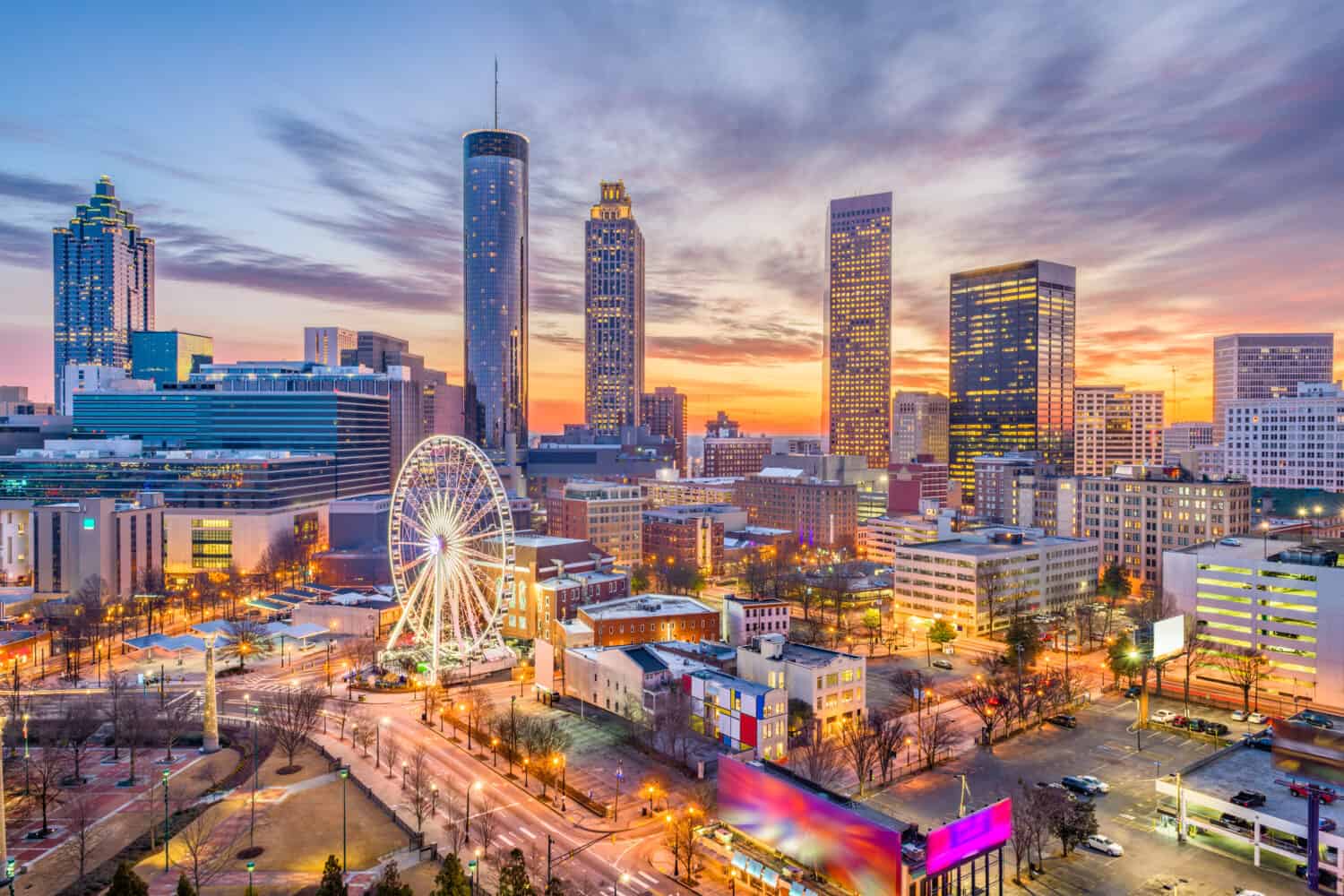Georgia has diverse landscapes ranging from mountains to coastal plains. It is also no stranger to the challenges posed by flooding. While the state enjoys a temperate climate and scenic beauty, its geography also exposes it to various forms of flooding. This includes riverine, flash, and coastal flooding. In this article, we will explore the 10 towns in Georgia that are most prone to flooding. We will also examine the contributing factors, any historical events, and efforts to mitigate flood risks.

1. Savannah
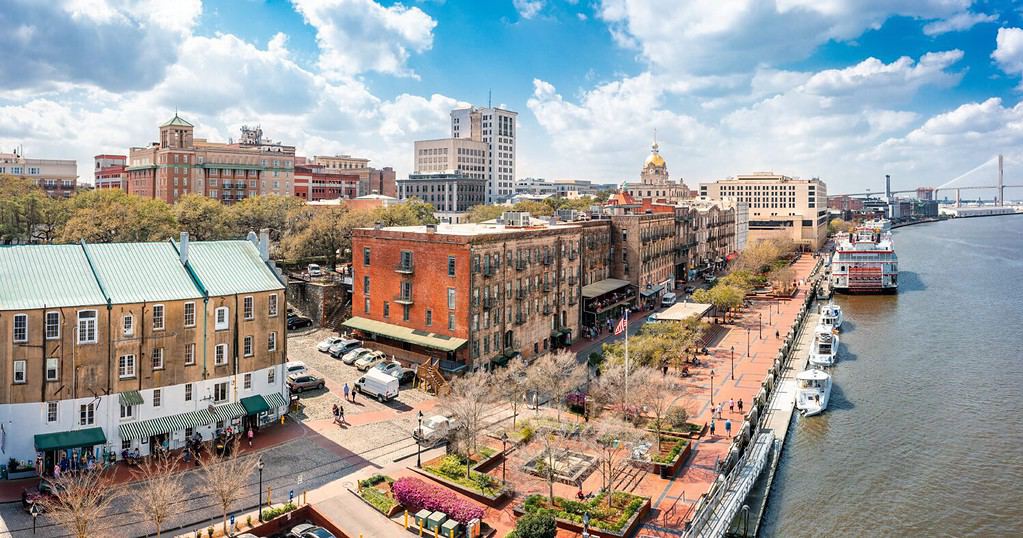
Savannah, Georgia is a popular destination for history, food, and beach lovers.
©Mihai_Andritoiu/Shutterstock.com
The historic city of Savannah, located on the state’s southeastern coast, is one of Georgia’s most iconic cities and also one of its most flood-prone. Situated near the convergence of the Savannah River and the Atlantic Ocean, the city faces the dual threat of riverine and coastal flooding. The city’s low-lying areas, including downtown Savannah and the historic district, are particularly vulnerable during storm surges and heavy rainfall events.
Historical floods, such as Hurricane Matthew in 2016 and Hurricane Irma in 2017, have inundated parts of the city. They have also caused damage to homes and infrastructure. The threat of sea-level rise due to climate change further exacerbates the flooding risks for Savannah. To address these challenges, the city has implemented flood mitigation measures, including improved drainage systems and seawalls.
2. Augusta

The Savannah River flows through Augusta and makes it prone to floods.
©Kevin Ruck/Shutterstock.com
Augusta, often referred to as the “Garden City,” sits along the banks of the Savannah River in eastern Georgia. While the city’s location along the river gives it picturesque views, it also makes it susceptible to riverine flooding. The Augusta Canal, which runs through the city, can overflow during heavy rains, causing localized flooding.
Historically, the city has experienced significant floods, most notably the Great Flood of 1929. That flood inundated large areas of Augusta. Since then, efforts have been made to reduce flooding risks, including the construction of levees and reservoirs to control water flow. Despite these measures, Augusta remains vulnerable to riverine flooding. This is especially true during hurricane seasons and periods of intense rainfall.
3. Valdosta

front view of the Lowndes County Courthouse in Valdosta, Georgia
©talentbender/iStock via Getty Images
Valdosta, located in the southern part of Georgia, is another town with a history of flood-related challenges. Situated near the confluence of several rivers, including the Withlacoochee River, Little River, and the Alapaha River, Valdosta experiences riverine flooding risks during heavy rain events.
Over the years, Valdosta has experienced periodic flooding, leading to property damage and disruptions in daily life. The city has worked to mitigate these risks through floodplain management and the enhancement of its stormwater infrastructure.
4. Albany
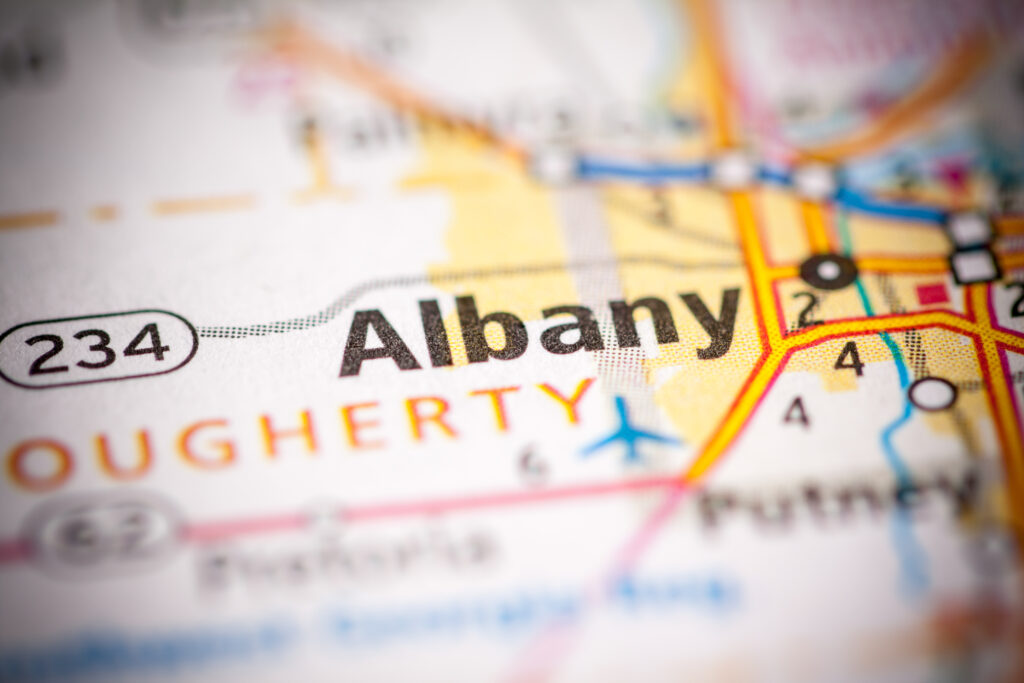
Albany is prone to flooding in Georgia, due to the Flint River.
©SevenMaps/Shutterstock.com
The city of Albany, a southwest Georgia city, is situated along the Flint River. This makes it prone to riverine flooding. The city has faced several significant floods in its history, including the devastating flooding caused by Tropical Storm Alberto in 1994.
The 1994 flood, often referred to as the “Great Flood of ’94,” resulted in extensive damage to homes and businesses in Albany. Subsequent efforts focused on improving flood forecasting, emergency response, and floodplain management. Despite these measures, the city remains at risk during heavy rainfall and storm events. This emphasizes the importance of ongoing flood preparedness and mitigation.
5. Rome
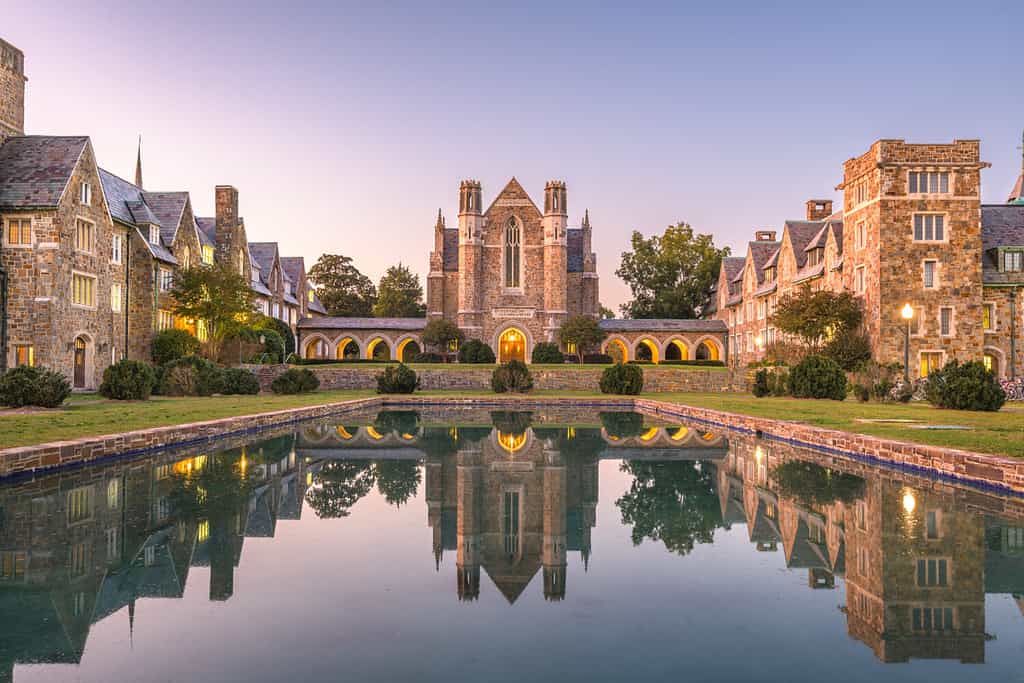
Historic campus at twilight near Rome, Georgia, USA.
©Sean Pavone/Shutterstock.com
Rome, nestled along the banks of the Oostanaula and Etowah Rivers, faces riverine flooding risks due to its location. The convergence of these two rivers forms the Coosa River, which flows through the city and creates the potential for flooding during periods of heavy rain.
Historical floods, such as those in 1886 and 1929, have left their mark on Rome. The city has implemented flood control measures, including levees and reservoirs, to reduce flood risks. Still, Rome remains susceptible to riverine flooding, particularly during severe weather events.
6. Columbus

The city of Columbus, Georgia, USA downtown skyline on the Chattahoochee River.
©LiliePhoto/Shutterstock.com
Columbus, situated in western Georgia along the Chattahoochee River, has to deal with riverine flooding risks. This is due to its proximity to this major waterway. The Chattahoochee River Basin can experience increased water levels during prolonged rainfall, leading to potential flooding in Columbus.
Historical floods in the area, such as the Great Flood of 1990, caused significant damage to homes and infrastructure. In response, the city has developed floodplain management plans, improved monitoring systems, and enhanced emergency response capabilities. These measures have helped mitigate flooding risks, but the potential for riverine flooding still remains a concern for Columbus.
7. Macon
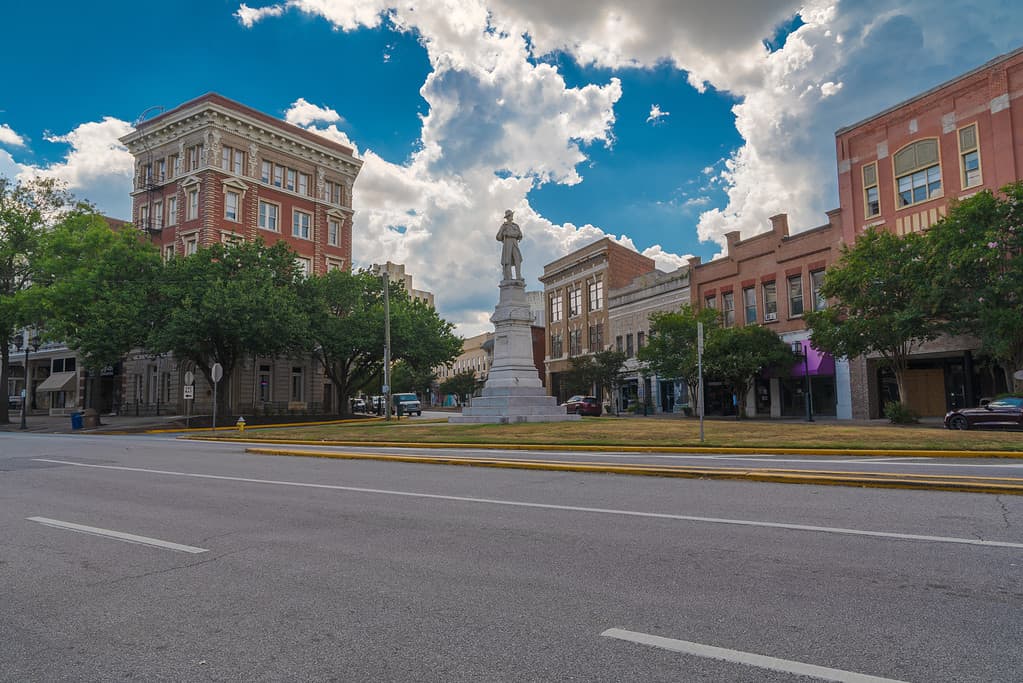
Confederate Statue on Cotton Ave. in Historic Downtown Macon, GA. This statue is to be moved in the near future to a local cemetery.
©iStock.com/Doug Nurnberger
Macon, located in central Georgia, is another town susceptible to riverine flooding, primarily due to its proximity to the Ocmulgee River. The Ocmulgee River Basin faces high water levels during heavy rains, which can lead to localized flooding.
Macon has faced historical floods, such as those in 1994 and 2009, which inundated several local neighborhoods and disrupted daily life. To address these challenges, the city has implemented floodplain management strategies and invested in stormwater infrastructure improvements.
8. Brunswick
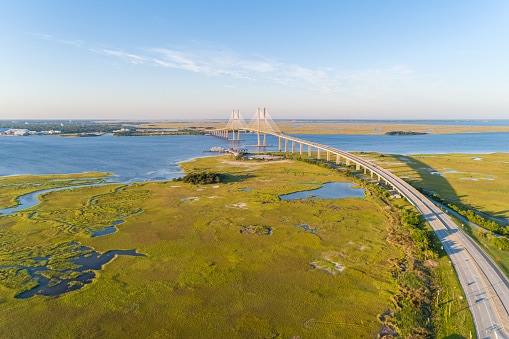
The Sidney Lanier Bridge takes northbound motorists on U.S. Highway 17 into the coastal Georgia city of Brunswick.
©Allen Allnoch/iStock via Getty Images
Brunswick, a coastal city in southeastern Georgia, faces a unique flooding challenge. This amounts to coastal flooding due to its location along the Atlantic Ocean and the intracoastal waterway. The city’s low-lying coastal areas are particularly vulnerable during hurricanes and tropical storms, which can bring storm surges and heavy rainfall.
Historical storms like Hurricane Matthew in 2016 and Hurricane Dorian in 2019 caused coastal flooding in Brunswick, impacting homes and businesses. To mitigate these risks, the city has focused on enhancing its coastal defenses, including seawalls and dune restoration projects. Additionally, floodplain management and evacuation plans are also critical components of Brunswick’s flood preparedness efforts.
9. Waycross

Aerial view of the southeastern Georgia town of Waycross on a cloudy winter day.
©Allen Allnoch/iStock via Getty Images
Waycross, located in southeastern Georgia, is susceptible to flooding due to its proximity to the Satilla River and the Okefenokee Swamp. Heavy rainfall events can thus lead to riverine flooding in the area.
Historically, Waycross has experienced flooding several times, with notable events occurring in 1947 and 2004. In response to these challenges, the city has undertaken flood mitigation projects, including the construction of levees and improved stormwater management.
10. Toccoa
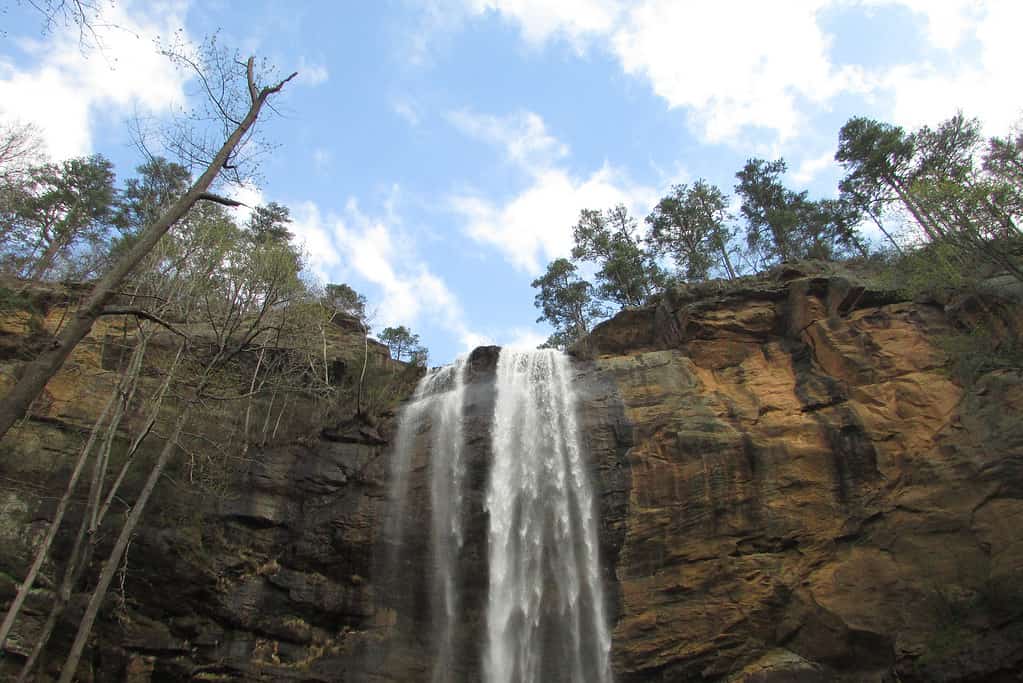
Beautiful photo of Toccoa falls in Toccoa Georgia, Highly recomend as a place to visit, very wonderful landscape and kind people.
©TravelPerks/ via Getty Images
Toccoa, nestled in the foothills of the Appalachian Mountains in northern Georgia, faces the risk of flash flooding due to its hilly terrain and proximity to rivers and creeks. Flash floods can occur rapidly, particularly during intense thunderstorms.
While Toccoa may not experience riverine or coastal flooding like some of the other towns on this list, flash flooding still remains a major concern. The city has implemented measures to improve drainage systems and enhance stormwater management to mitigate flash flood risks. Additionally, residents are encouraged to stay vigilant during severe weather events and heed any evacuation warnings.
Most Flood-Prone Towns in Georgia Summary Table
| Rank | Town | Location | Type of Flooding Risk | Historical Floods |
|---|---|---|---|---|
| 1. | Savannah | Southeast Coast | Riverine, Coastal | Hurricanes Matthew & Irma |
| 2. | Augusta | Eastern Georgia | Riverine | 1929 Great Flood |
| 3. | Valdosta | Southern Georgia | Riverine | Periodic localized floods |
| 4. | Albany | Southwest Georgia | Riverine | Tropical Storm Alberto |
| 5. | Rome | Northwest Georgia | Riverine | 1886 & 1929 floods |
| 6. | Columbus | Western Georgia | Riverine | 1990 Great Flood |
| 7. | Macon | Central Georgia | Riverine | Floods in 1994 & 2009 |
| 8. | Brunswick | Southeast Coast | Coastal | Hurricanes Matthew & Dorian |
| 9. | Waycross | Southeast Georgia | Riverine | Historical floods in 1947 & 2004 |
| 10. | Toccoa | Northern Georgia | Flash | Flash floods during thunderstorms |
Thank you for reading! Have some feedback for us? Contact the AZ Animals editorial team.

